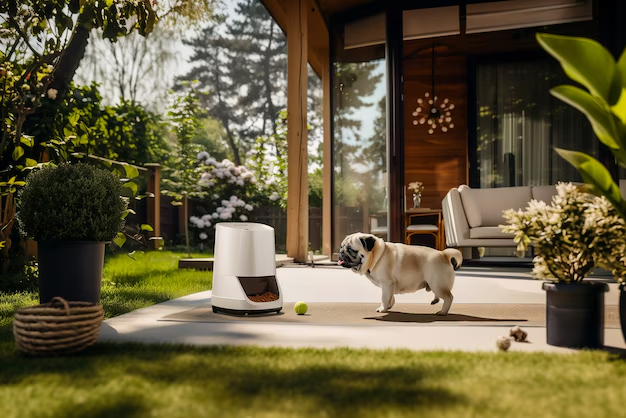As we step into 2025, the world of smart homes is experiencing a transformative shift, driven by innovative technologies that are redefining the way we live, work, and interact with our living spaces. Smart home trends are not just about integrating gadgets; they are about creating a seamless, efficient, and sustainable living environment that enhances comfort, security, and convenience. This article explores how technology is changing home and garden design, highlighting the latest trends and their impact on modern living.
Introduction to Home And Garden Design
Smart homes are no longer a futuristic concept but a reality that many are embracing. These homes are equipped with advanced technologies that allow homeowners to control various aspects of their living space remotely or through voice commands. From lighting and temperature to security and entertainment, smart home solutions are designed to make life easier and more enjoyable.
AI-Powered Home Automation

One of the most significant trends in smart homes is the integration of Artificial Intelligence (AI). AI-powered systems learn the habits and preferences of homeowners, adjusting settings such as lighting, temperature, and security automatically. This predictive automation ensures that homes are always optimized for comfort and efficiency. For instance, AI can adjust the lighting in a room based on the time of day or the activity being performed, creating a personalized ambiance that enhances the living experience.
Energy-Efficient Smart Homes
With growing concerns about sustainability and rising energy costs, smart homes are focusing on energy efficiency. Smart thermostats, solar-integrated energy systems, and AI-powered appliances are designed to reduce energy consumption while maintaining comfort. Energy monitoring apps allow homeowners to track their usage in real-time, making it easier to optimize energy efficiency and cut electricity bills. This not only saves money but also contributes to a more sustainable lifestyle.
Advanced Home Security Solutions
Security remains a top priority in smart home design. In 2025, smart security systems are becoming more intelligent and proactive. Features like facial recognition doorbells, AI-powered cameras, and smart locks with biometric authentication offer enhanced protection. Integration with law enforcement and emergency services further improves response times in critical situations, providing homeowners with peace of mind whether they are at home or away.
Smart Kitchens for Convenience
The kitchen is becoming the heart of the smart home. Smart refrigerators, ovens, and dishwashers now feature AI-powered meal planning, recipe suggestions, and automated cooking modes. Voice-controlled appliances and IoT-enabled grocery management ensure convenience and reduce waste. These innovations make cooking easier and more enjoyable, allowing homeowners to spend more time on what matters most.
Health-Focused Smart Homes

Post-pandemic, health-conscious living is a growing trend. Smart homes in 2025 feature air purification systems, UV-C light sterilization, and contactless faucets to enhance hygiene. Wearable health devices integrate with home automation, adjusting lighting and temperature to promote wellness and better sleep. This focus on health creates a living environment that supports overall well-being.
Smart Furniture & Space Optimization
As urban living spaces shrink, smart furniture is gaining popularity. Convertible beds, robotic storage solutions, and AI-assisted interior design help maximize space efficiency. Voice-controlled lighting, motorized blinds, and automated work-from-home setups create adaptable living environments that are both functional and comfortable.
Seamless Connectivity with Matter Protocol
The Matter protocol is revolutionizing smart home connectivity by creating a universal standard that allows devices from different manufacturers to work together seamlessly. This technology enhances interoperability, security, and user experience, offering intuitive interfaces and improved voice control. With Matter, setting up smart home systems becomes easier, eliminating compatibility issues and simplifying home automation.
Voice & Gesture Control Innovations
Beyond voice commands, gesture control and eye-tracking technology are making home automation more intuitive. Imagine adjusting lights with a wave of your hand or changing TV channels with eye movements—these futuristic interactions are becoming a reality. This innovation in user interfaces makes smart homes more accessible and enjoyable for everyone.
Water-Saving Smart Technology

Water conservation is a growing concern, leading to the rise of smart water meters, automated irrigation systems, and leak-detection sensors. These solutions help homeowners reduce water wastage and manage usage efficiently, contributing to a more sustainable future.
Home Robots for Assistance
Robotic technology is advancing, with AI-driven home assistants performing tasks like vacuuming, dishwashing, and even companionship for the elderly. Home robots are no longer futuristic dreams but practical additions to modern homes, enhancing convenience and companionship.
Also Read : The Best Outdoor Lighting Ideas To Transform Your Garden
Conclusion
In 2025, smart home trends are transforming the way we live, work, and interact with our homes. From AI-powered automation to energy-efficient solutions, smart homes are becoming more connected, efficient, and secure. As technology continues to evolve, we can expect even more innovative solutions that enhance comfort, sustainability, and convenience.
FAQs
What is the role of AI in smart homes?
AI plays a crucial role in smart homes by learning user habits and adjusting settings like lighting and temperature automatically, enhancing comfort and efficiency.
How do smart thermostats contribute to energy efficiency?
Smart thermostats learn your preferences and adjust the temperature to ensure comfort while saving energy, especially when no one is home.
What is the Matter protocol, and how does it benefit smart homes?
The Matter protocol is a universal standard that allows devices from different manufacturers to work together seamlessly, enhancing interoperability and user experience.
How do smart kitchens enhance convenience?
Smart kitchens feature AI-powered meal planning, voice-controlled appliances, and IoT-enabled grocery management, making cooking easier and reducing waste.
What role do home robots play in smart homes?
Home robots assist with tasks like vacuuming, dishwashing, and companionship, enhancing convenience and companionship in modern homes.

